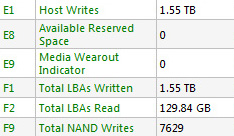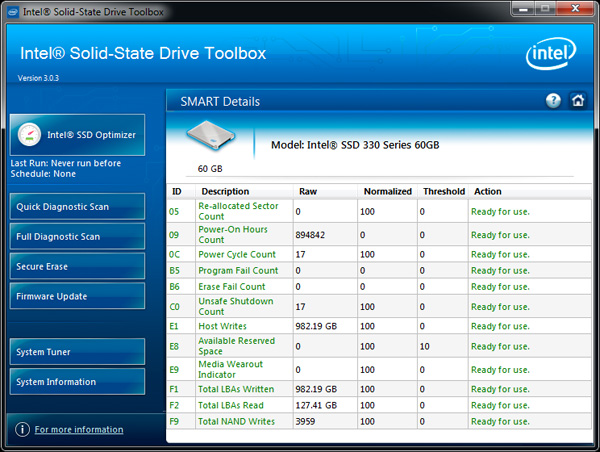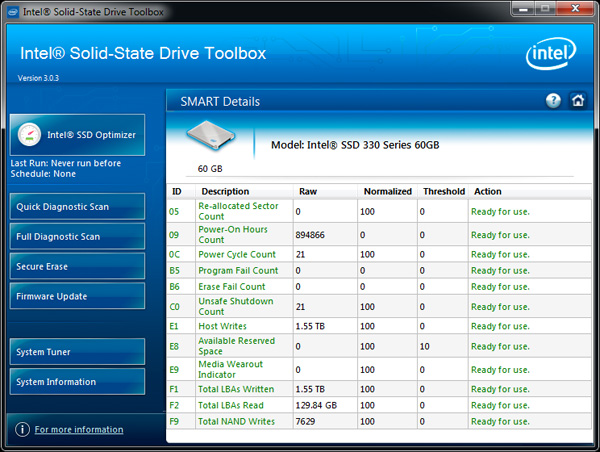The Intel SSD 330 Review (60GB, 120GB, 180GB)
by Anand Lal Shimpi on August 1, 2012 12:01 AM ESTLower Endurance: A Non-Issue
We've mentioned time and time again that NAND endurance is a non-issue for desktop (and even some enterprise) workloads.
Intel doesn't quantify the difference in endurance between the NAND used on the SSD 330 and the 520, it simply states that the 330's NAND will deliver a useful lifespan of 3 years and thus carries a 3 year warranty. Unfortunately, without access to the E2/E3/E4 counters we can't quickly figure out how long the 330 would last given a typical client workload. Thankfully Intel left one SMART wear indicator intact: the E9 attribute, otherwise known as the Media Wearout Indicator.
The normalized value of the E9 attribute (accessible via any SMART monitoring software, or Intel's SSD Toolbox) starts at 100 and decreases, linearly by integer increments, down to 0. Its meaning? The number of cycles the NAND media has undergone. At 100, your NAND is running at roughly full health. At 90, you've exhausted 10% of your NAND's lifespan. By the time the E9/MWI attribute gets down to 1 (99% of NAND p/e cycles have been used up) the counter stops decrementing and you're recommended to replace the drive. Even Intel admits however it's quite likely that at a value of 1 your drive will last for a considerable amount of time.
These are SandForce drives that implement real time data deduplication/compression so I wanted to create the worst case scenario to see how big of a deal this lower endurance NAND would be. I filled the 60GB Intel SSD 330 with incompressible data, leaving only its spare area untouched. I then ran a 4KB random write test, at a queue depth of 32, using incompressible data in four blocks of 6 hours, stopping only to look at the state of the E9/MWI attribute.
Even after 3959GB written to the 60GB drive, the media wear indicator remained at 100. If we do the math and assume that Intel isn't lying about the attribute decreasing linearly from 100 down to 0, it's possible the NAND on this particular 60GB SSD 330 is good for at least 6000 p/e cycles (3959GB/64GB = ~61 p/e cycles per NAND cell).
Not satisfied with these results I went in for another 24 hour round. By the end of it I had written 7629GB to the 60GB drive, at around 119 p/e cycles per NAND cell (assuming perfect wear leveling). The MWI hadn't budged:
Extrapolating based on this data you'd end up with over 10,000 p/e cycles for this particular drive. Whether or not this is accurate remains to be seen, but endurance is clearly not going to be an issue with Intel's SSD 330.
If you assume a typical client drive sees 10GB of writes per day, within a year you'd write 3650GB to the drive. I wrote that much in 24 hours. In fact, I wrote more than two years worth of data to the 60GB Intel SSD 330 in two days. All the while the Intel SSD 330 didn't even blink.
Note that as with any form of binning, you will see examples of drives that do better or worse than the one I've tested. Unless there's something horribly wrong with Intel's 25nm NAND process however, the difference is unlikely to be large enough where it'd be an issue.
As a side benefit to all of this experimenting with death is we can actually quantify write amplification on a SandForce drive.
Intel's 300i firmware, like all SandForce firmware, keeps track of NAND vs. host writes. Using that data I'm able to quantify write amplification during this fairly worst-case scenario workload:

7629GB of NAND writes vs. 1550GB of host writes = ~4.9x write amplification
SandForce maintains extremely low write amplification, even when faced with a hefty workload. Typical write amplification for client users will likely be far lower.












64 Comments
View All Comments
Oxford Guy - Wednesday, August 1, 2012 - link
Yeah, the old version of the software detected the drive as being a 500 series.This looks like a bug to me.
A5 - Wednesday, August 1, 2012 - link
The next paragraph of the article shows that the latest SSD Toolbox properly detects the drive. It's safe to assume that that is what Anand used for testing.chrnochime - Wednesday, August 1, 2012 - link
I heard about the 8mb problem with intel 320 SSDs. Is that still problem with these new SF based SSDs?Per Hansson - Wednesday, August 1, 2012 - link
That problem is only with Intel's own controller, not Sandforce so this drive and the 520 should be fine...marioyohanes - Wednesday, August 1, 2012 - link
I have one of this SSD installed on my 2011 Mac, and it doesn't work well with sleep and also always caused major crash after software update (like any other SF 22xx SSD). Then my friend who recently bought HP Envy also got this SSD by default from HP, guess what, screen goes black after sleep (not all the time, but most of the time), crashed after 1 month he had to reinstalled the entire thing and lost his data. Now, after 6 months and after 5 times RMA, he ended up reformatting his drive every month.I just wish Anand more honest by telling people the truth about SSD, specially SF based controller, because after trying more than 5 SF based SSD, I can say they're sucks! buy it only if you're planning to reformat your drive every now and then. Good for benchmark score, but not for daily use. Contest only probably. However, my Intel 320 and Crucial M4 stays reliable even after years of heavy use.
Oxford Guy - Wednesday, August 1, 2012 - link
I, and two colleagues, have 240 GB Sandforce drives (1x Vertex 2, 2x Chronos DX). None of them have given us any problems. I'm using mine in a 2008 Macbook Pro and they are using theirs in 2011 Macbook Pros. All of us have TRIM enabled.Did you make sure to update the firmware to the latest version before using the drive in your Mac?
Also, older versions of OS X should have the feature disabled that copies the contents of RAM to disk when the machine is put to sleep.
angelsmaster - Tuesday, September 4, 2012 - link
hi, i just bought yesterday this intel 330 series, and i am also using mac 2011, haven't updated yet cause i could not find the firmware ware update for this 240 gb, i could only find are for 60 ~ 180 gig firmware update, i tried downloading and its error due to .exe . and the TRIM is not supported.. and idea on this? thank!eviloz_i - Wednesday, August 1, 2012 - link
i have a 320 drive (120gb) a 520 drive (60gb) and a 330 (60gb), the first two on intel mb, third on asus mball installed directly with windows7 x64 without any ssd-specific procedure in the bios or in the os (just for paranoia, checked if trim was enabled after install. it was)
they all perform flawlessly, all pc regularly jump in an out of both turn-off-video screen saver and suspend.
I never benchmarked them, i dont need astral performance, but they are fast.
murakozi - Wednesday, August 1, 2012 - link
Swapped out all HDD-s in our office and home computers (that is: HP 6910p, HP NC 6400, HP TC 4400, 2 x Dell Optiplex 790 DT, Dell Optiplex 755 DT, HP XW8400) without issues. OS variety: XP Prof, Vista Prof SP2, Win7 Prof).Works like a charm, any time. The only product I ever had problems with was Seagate Momentus XT 500 GB, which - even after several installs and OS-es - produced corrupted blocks and r/w failures within days.
IMHO the SSD products have matured enough to use them in "mission critical" enviroments (I have them also in our office server, the old box literally flies...)
Ammaross - Thursday, August 2, 2012 - link
I've rolled out 10 identical workstations, each outfitted with a 60GB Intel 330 drive, all running the same Win7 image. Of those 10, 1 immediately started giving us problems. The OS would "stutter," locking up for seconds at a time. I narrowed it down to the SATA link power management features of Windows. Apparently, these drives still have issues when their SATA link is put into idle/low power modes. Replaced the drive with a Vertex 3 and all was well.